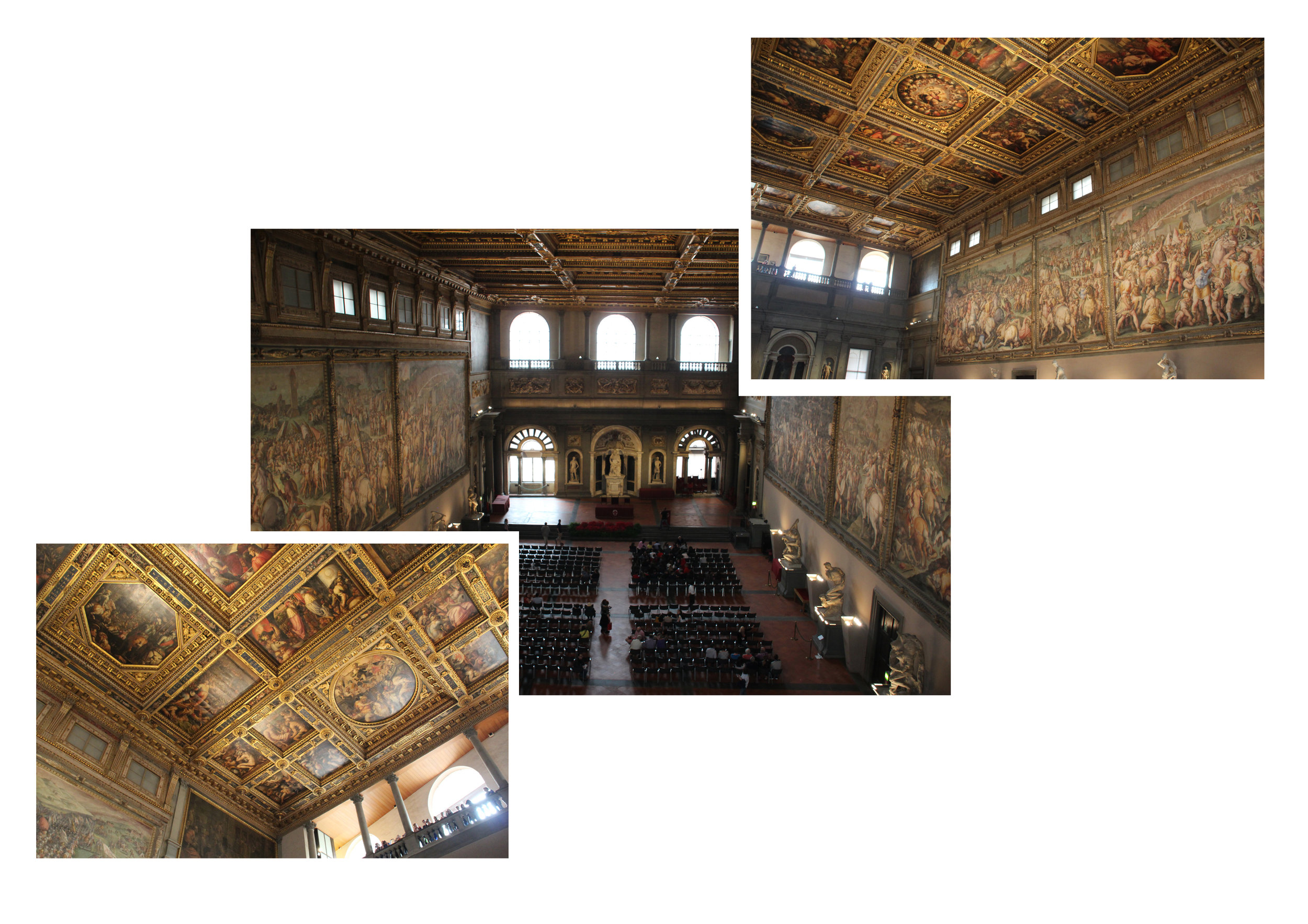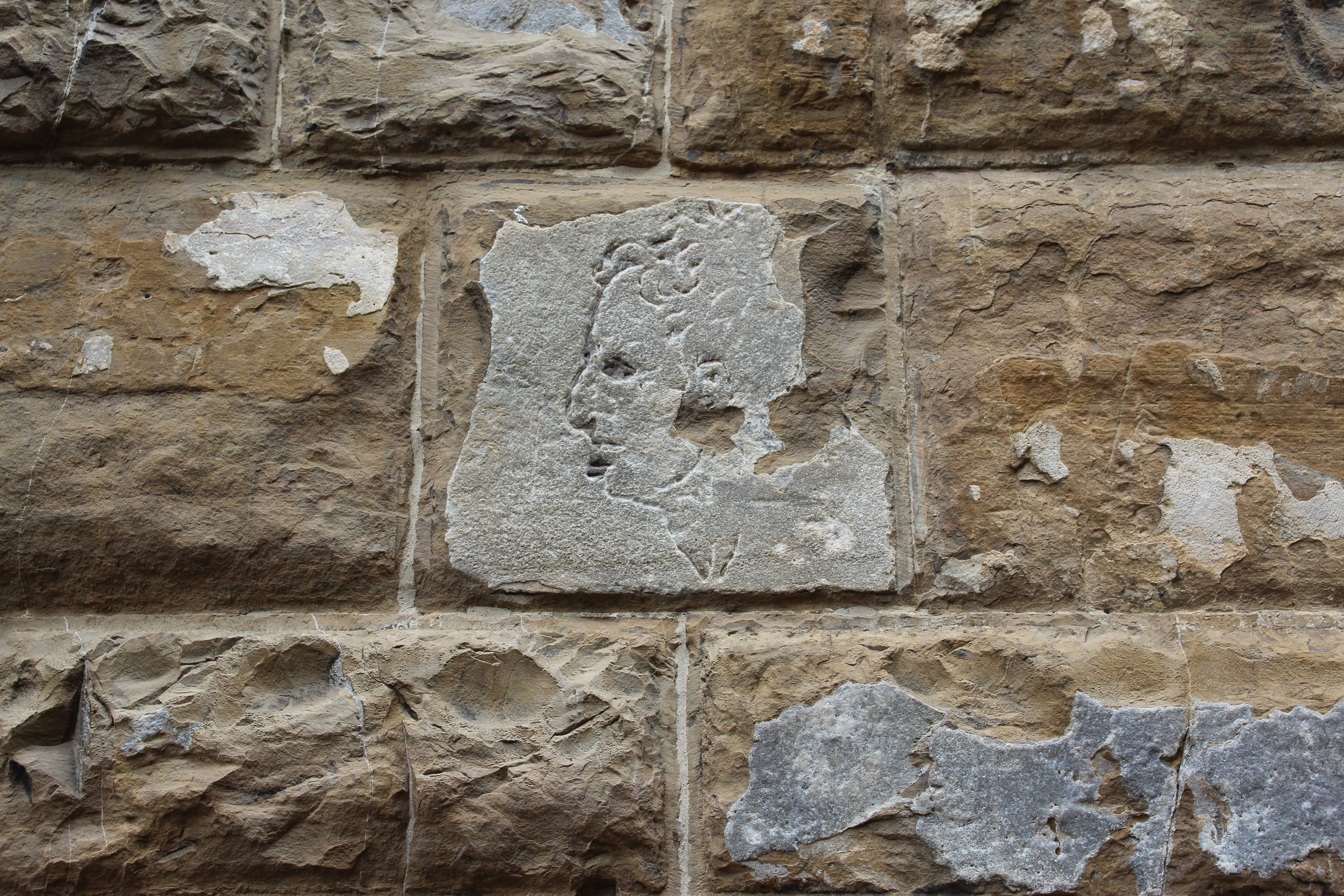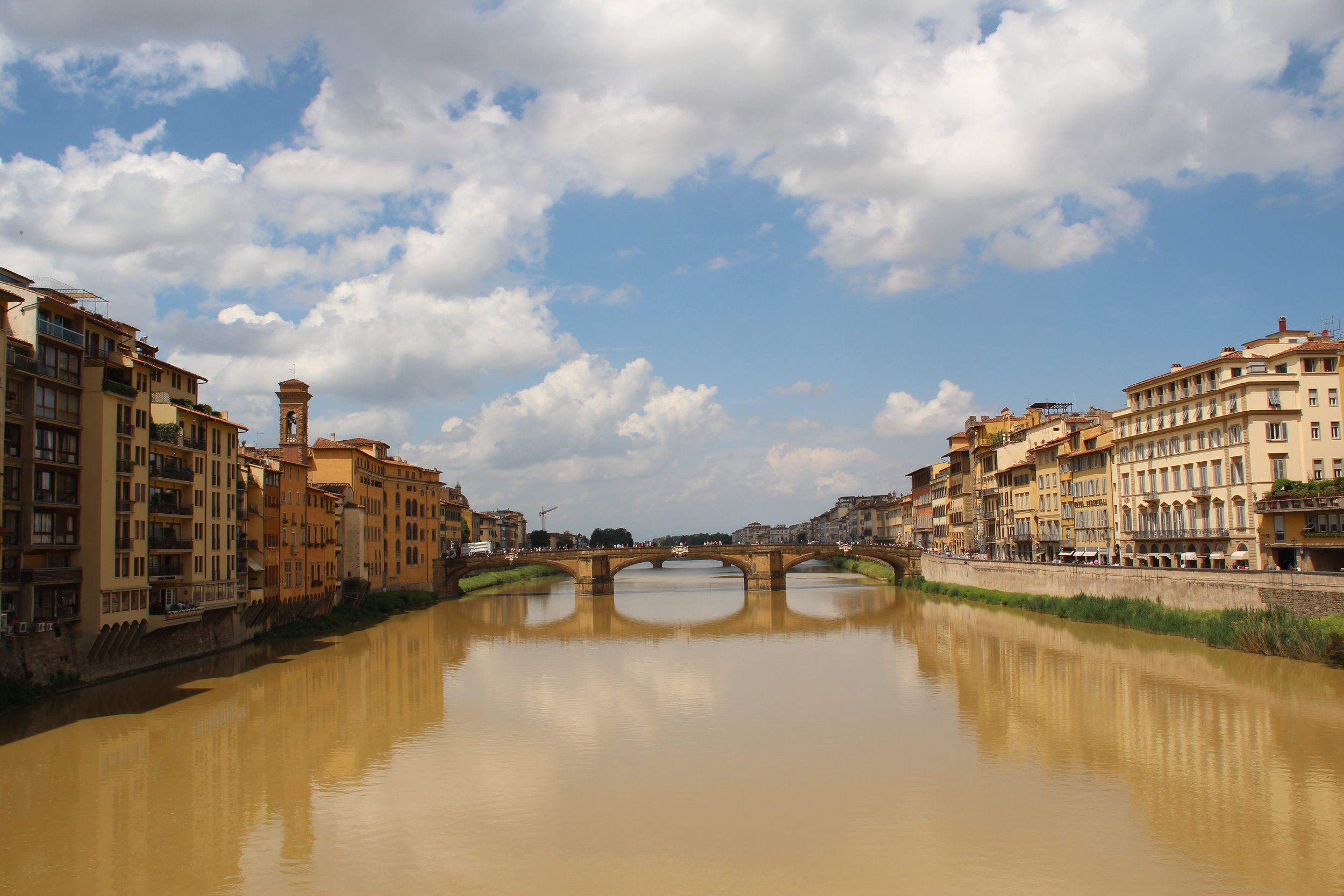How to Explore Florence like an Art History Major: Part Two – Architecture for the Nobles
This is Part Two of a four-part series on how to explore Florence like an Art History major. Here, I’ll share the beautiful architecture in the city of Florence that was erected for the nobles.
1. Palazzo Vecchio
What was once the seat of government is today the town hall of Florence and a museum. The whole palazzo is like a time capsule, allowing you to walk through different periods in Florentine history. But the true gem for me was the Salone dei Cinquecento. The current appearance is due to the renovations in the 1500s when Duke Cosimo I de’ Medici made the palazzo his residence (he held his court in this hall). Unfortunately, prized works by Michelangelo and da Vinci have been lost (apparently da Vinci decided to experiment with wax and pigment, realized that it wasn’t drying fast enough, used heat to dry the paint, and well…the whole fresco melted. As for Michelangelo, his preparatory sketches were destroyed before he could even begin.) What exists today is by Giorgio Vasari and his pupils from the later part of the 16th century.
Be prepared to get a kink in your neck when staring at the gilded and ornate ceiling. The gold seems to illuminate the whole hall with a beautiful warm light (that unfortunately your camera may never be able to truly capture). Every inch is covered in precious artwork that it is almost impossible to see everything. The walls are also covered with very large frescoes depicting a battle, with bodies filling up every corner. The amount of detail in the Salone dei Cinquecento, the artwork, the ornateness…it can feel overwhelming. So take a moment to sit down and let your eyes and thoughts wander throughout this beautiful room.
Outside the palazzo, there is hidden gem (thank you Nadia - the editor of this site - for showing this to me). To the right of the entrance to the palazzo, near the corner of the building, exists a graffito by Michelangelo. It is so easy to miss and doesn’t appear like anything special, until you realize there is a man’s face carved into the stone wall. There are lots of stories behind the reason as to why the artist depicted this. One states it was done on a dare behind his back. Another states he was bored. And another states that he depicted a man who had been executed. Whether L’importuno di Michelangelo was actually created by the artist and whether any of the various stories are true, I will choose to believe that I stood inches away from something created by a Renaissance master.
2. Piazza della Signoria
Outside of the Palazzo Vecchio is the Loggia dei Lanzi. This relatively small space appears like an open-air gallery full of artistic value, where you can walk from masterpiece to masterpiece or choose to sit on the steps inside and let your mind wander. I have a deep appreciation for Renaissance sculptures. I look at these carved pieces and wonder how on earth these artists were able to take a solid stone and create something so human and real, as though inside these stones existed a body that needed to be freed (as Michelangelo himself said with his own sculptures).
Although every sculpture deserves equal attention, three stood out to me. One of the first sculptures that can be seen on the right of the Loggia is the Rape of the Sabine Women by Giambologna (1579-1583). This is probably one of my favourite Renaissance sculptures I have ever studied or seen. The legend behind this sculpture comes from Roman mythology. Romulus (one of the founders of Rome) and other Roman males were seeking wives from the Sabine tribe, but were refused by the Sabines who did not want any men from Rome to marry their women. Sneakily, the Romans held a festival and invited the Sabine tribe. A signal was given, at which the Romans grabbed the Sabine women, while fighting off the Sabine men. This moment in the legend is what is depicted in the sculpture. Having the knowledge behind the legend helps to understand the misleading title. A rape did not occur, but an abduction (the Latin word rapito means “abduction”; therefore, a more accurate translation is Abduction of the Sabine Women).
This sculpture was carved from a single block of marble (yes, my mind was blown away as well). The three figures (from bottom to top: Sabine man, Roman man, Sabine woman) are intwined in what is called “figura serpentinata”, which means that the figure doesn’t have a front, but a 360 degree view in order to appear more dynamic. Each angle presents a new view and evokes different emotions. The figure of the Sabine male at the bottom is in a position of self-defence. You can feel his pain at seeing the Sabine woman being abducted. His crouched figure beneath the strong, Roman male looks almost as helpless as the Sabine woman. The Roman male, steeping over the Sabine, has his feet firmly on the ground, holding the woman in a vice-like grip. His grip is so tight that you can see his fingers pressing into her skin (this detail makes the sculpture seem even more alive). Finally, the Sabine woman looks utterly helpless with her arms grasping at thin air, looking over her shoulder as if hoping that someone will come save her. The definition of the arms and backs, the softness of the woman skin, the sheer realism of the bodies made it very difficult to tear my eye away and move on to the next sculpture.
The next sculpture, another one by Giambologna (1529-1608), stands right behind the Rape of the Sabine Women. Also carved from a single block of marble, this sculpture depicts Hercules beating the Centaur Nessus. The physical strength of Hercules makes you feel like you should take a step back, as if you are entering their realm of battle. Hercules raises his right arm, gripping a baton so tightly that you can see his taunt muscles. He is frozen in mid-swing, although you feel as though at any minute, his arm will come down and defeat Nessus. His face shows pure determination and as though he hasn’t broken a sweat in this fight. On the contrary, Nessus is clearly in pain. Bent almost in half, Nessus raises his arms, his right hand trying to pry away the hand of Hercules from his head and his left hand pushing Hercules away (you can even see the indentations of the hand of Nessus as it pushes into his opponents skin). Nessus is in a position of defeat; his front legs are bent oddly, the veins appearing as though pulsating.
The third sculpture is one that isn’t from the Renaissance, but from 1868. It was sculpted by Pio Fedi and is entitled The Rape of Polyxena. This sculpture presents a new story that combines inspiration from various other sculptures, styles and from Ovid’s Metamorphoses. There is so much realism in this sculpture that you feel sadness while looking at the woman beneath the strong male, the woman who appears to be pleading for the salvation of possibly her daughter (this woman has wrinkles beneath the eyes to suggest she’s older). A detail that is easy to miss are the tears that are carved by the side of this woman eyes. You can see how distraught she is with her furrowed brow and downturned mouth. On the contrary, the military man has a menacing sneer. Like the sculpture of Hercules beating the Centaur Nessus, this figure also has his arm raised moments before he strikes his weapon. Other details to take note of are the older woman hands. The one on the man isn’t gripping very hard; it’s almost gentle, as though trying to convince the man to spare the girl in his arms. Meanwhile, the grip on the young girl is tight, evident in the indentations on the skin. There is so much technical skill in this sculpture. The incredibly detailed folds of the cloth billowing behind the older woman, the feet of the fallen woman where it almost seems like it belongs to human (the wrinkles of the skin on the sole, the toenails, the natural positioning of each individual toe…).
Take your time admiring these sculptures. Walk around them, look past the sculpture as a whole and look into the individual details that make them masterpieces.
3. Ponte Vecchio
One of the most beautiful bridges I have ever seen, Ponte Vecchio is not only a place for a passeggiata, but also full of historical value. Since the 13th century, the bridge has had various shops such as butchers, tanners, fishmongers…basically really stinky shops. In 1593, Ferdinand I changed this by only having goldsmiths and jewellers to sell on the bridge. To this day, you will find shop after shop containing beautiful gold jewellery (that will definitely make your wallet feel lighter). While walking down the bridge, if you look up you will see a corridor. This is the Corridoio Vasariano (named after Vasari who designed it) and it was built in 1564. It was ordered by Cosimo I de’ Medici to act as a passageway that connected the Gallerie degli Uffizi to the Palazzo Pitti (he wanted to be able to walk freely and privately, rather than in public like a commoner and away from the stench on the bridge). This extremely long corridor, which is almost a kilometre long, is quite fun to keep track of as you walk over the bridge. Unfortunately when I was in Florence, the corridor was closed to visitors due to renovations (there is an art gallery inside).
I am not only an art history lover, but also very passionate about WW2 history and this bridge has a place in that period of time. The beauty of the bridge that today is so easy to see was also noticed by Hitler. Being an “art lover” he decided to spare this bridge (but he had no qualms about bombing the rest of the city…). Along the bridge there are small circular windows, which are the original ones. In the centre of the bridge is a set of three larger, square windows.
These were placed on the orders of Mussolini, who wanted to create a viewing gallery for Hitler’s visit to the city (this is apparently where Hitler was inspired to not bomb the bridge). You don’t have to go into the corridor and stand before these windows to see the beautiful view of the city. Right in the very centre before these windows is a bust of the artist Benvenuto Cellini that is surrounded by a gate with love locks. Not only will you see a beautiful panorama, but also be surrounded by the hope of love. Not a bad combination.
4. Palazzo Pitti
Ceiling in the Sala di Marte
This beautiful and enormous palace became the official residence of Francesco I (the son of Grand Duke Cosimo I de’ Medici and his wife Eleonora da Toledo) and his wife Johanna of Austria. There is so much art to see within this palace, but the most extraordinary sights are the ceilings. Every room you walk into depicts an entirely new story, painted with so much detail that you wonder how could one possibly have done this when simply looking up for a few minutes causes neck pain (the pain is worth it though). These ceilings depict myths, many of which are allegories that reflect the Medici family. One of the most obvious ones is in the Sala di Marte, a room dedicated to introducing nobles to the Grand Duke. The ceiling depicts an allegory of the Prince defeating his enemies and gaining power, with the Medici coat of arms and the Grand Ducal crown above (am I the only one who thinks the Medici coat of arms looks like a pizza?…).
In addition to all these places, keep your eyes open for the tiny details that exist in this city. Look out for the various street artists drawing on the street, the graffiti that exists on many walls, the unique street signs that have been altered to appear artistic and even witty. Like I wrote before, every corner you turn, you see something that stops you in your tracks.
More from
How to Explore Florence
like an Art Major
About the Contributor
Elizabeth Pandza
Hi, I’m Elizabeth! I was born and raised in Toronto, Canada (in a very Polish household, I might add). I grew up with a love for history, art, culture, and languages; a love that has made me desire to see every inch of this planet. When I’m not travelling or dreaming of travelling, I am usually painting, reading Harry Potter, watching Friends and the Office, or cuddling with my ginger cat/daughter Misia.

















